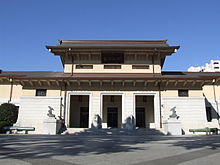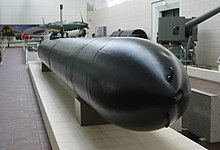Yūshūkan
 | |
 | |
| Established | 1882 |
|---|---|
| Location | Kudankita, Chiyoda, Tokyo, Japan |
| Type | Military and war museum |
| Website | www |
The Yūshūkan (遊就館, lit. 'Place to commune with noble souls') is a Japanese military and war
History

The museum was initially established in 1882 to preserve and display Meiji Restoration-era artifacts of the Imperial Japanese Army. Following the First Sino-Japanese War and Russo-Japanese War, the Meiji Emperor issued his 192nd order in 1910, which ordered the preservation of military artifacts.[5] The building was expanded when the number of documents and artifacts increased after World War I, but was demolished during the 1923 Great Kantō earthquake. The structure was rebuilt by Itō Chūta, reopening in 1932.[6]
During

Exhibitions


The museum's exhibitions are centered on the shrine's dedication to the spirits of deceased Japanese soldiers. The museum also contains weaponry used by the Imperial Japanese Army, as well as Allied documents and exhibitions related to the modern Japan Self-Defense Forces and United States Forces in Japan. A cenotaph of a war horse is also located within the museum grounds.
First floor
The first floor entrance hall can be entered free of admission, and contains an
The large exhibit room on the first floor contains a
Second floor
The entrance hall escalator leads to the second floor exhibit room. Various war-related materials are exhibited in chronological order, including different types of swords, armor, guns, and a golden flag wielded by the Imperial Japanese Army during the Boshin War. The war flag of the 321st Imperial Japanese Army division displayed in this room is the only one of its kind that has been recovered fully intact. The floor also contains a small cinema theater, which plays various documentaries related to the shrine and modern-day Japan.

Stores
The museum's gift shop sells regional souvenirs in addition to various books and documents concerning Yasukuni Shrine. Toy army flags and other military-related toys can also be purchased here, and English-language pamphlets are available for foreign visitors. The museum also houses a cafe where the items on the menu are created using ingredients and recipes resembling those actually used on Japanese Navy ships.
Revisionism
The museum contains
Appearances in literature
- Natsume Sōseki. The Tower of London (倫敦塔, Rondon Tō, 1905)
- Ryūnosuke Akutagawa. Aphorisms by a Pygmy (侏儒の言葉, Shuju no Kotoba, 1923)
References
- ^ "History". Retrieved 2008-03-23.
- ^ "yasukuni.jp" (in Japanese). Retrieved 2008-06-08.
- ^ a b Murphy, Paul. "Yasukuni Museum Tugs At Heartstrings To Keep Military Memories Alive". Asahi Shimbun News Service.
- ^ a b Simone, Gianni, "A trip around the Yushukan, Japan’s font of discord", The Japan Times, 28 July 2014
- ^ "Digital Archives". Retrieved 2008-06-08.
- Yasukuni Jinja. Retrieved 24 February 2012.
- Japan TimesRetrieved March 16, 2016
- Japan TimesRetrieved March 16, 2016
